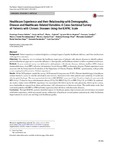Mostrar o rexistro simple do ítem
Healthcare experience and their relationship with demographic, disease and healthcare-related variables: a cross-sectional survey of patients with chronic diseases using the IEXPAC scale.
| dc.contributor.author | Orozco-Beltrán, Domingo | |
| dc.contributor.author | De-Toro, Javier | |
| dc.contributor.author | Galindo, María J. | |
| dc.contributor.author | Marín-Jiménez, Ignacio | |
| dc.contributor.author | Casellas, Francesc | |
| dc.contributor.author | Fuster-RuizdeApodaca, María J. | |
| dc.contributor.author | García-Vivar, María L. | |
| dc.contributor.author | Hormigo-Pozo, Antonio | |
| dc.contributor.author | Guilabert, Mercedes | |
| dc.contributor.author | Sánchez-Vega, Nuria | |
| dc.contributor.author | Fernández, Gonzalo | |
| dc.contributor.author | Cea-Calvo, Luis | |
| dc.date.accessioned | 2019-07-04T10:58:34Z | |
| dc.date.available | 2019-07-04T10:58:34Z | |
| dc.date.issued | 2018-11-15 | |
| dc.identifier.citation | Orozco-Beltrán D, de Toro J, Galindo MJ, Marín-Jiménez I, Casellas F, Fuster-RuizdeApodaca MJ, García-Vivar ML, Hormigo-Pozo A, Guilabert M, Sánchez-Vega N, Fernández G, Cea-Calvo L. Healthcare experience and their relationship with demographic, disease and healthcare-related variables: a cross-sectional survey of patients with chronic diseases using the IEXPAC scale. Patient. 2019 Jun;12(3):307-317. | es_ES |
| dc.identifier.issn | 1178-1653 | |
| dc.identifier.uri | http://hdl.handle.net/2183/23404 | |
| dc.description.abstract | [Abstract] BACKGROUND: Patient experience is acknowledged as a principal aspect of quality healthcare delivery, and it has implications with regard to outcomes. OBJECTIVES: Our objective was to evaluate the healthcare experience of patients with chronic diseases to identify patient-perceived healthcare gaps and to assess the influence of demographic and healthcare-related variables on patient experiences. METHODS: A cross-sectional survey was delivered to adult patients with chronic diseases: diabetes mellitus (DM), human immunodeficiency virus (HIV) infection, inflammatory bowel disease (IBD) or rheumatic diseases. Patient experiences were assessed with the Instrument for Evaluation of the Experience of Chronic Patients (IEXPAC) questionnaire, with possible scores ranging from 0 (worst) to 10 (best experience). RESULTS: Of the 2474 patients handed the survey, 1618 returned it (response rate 65.4%). Patients identified gaps in healthcare related mainly to access to reliable information and services, interaction with other patients and continuity of healthcare after hospital discharge. The mean ± standard deviation (SD) IEXPAC score was 6.0 ± 1.9 and was higher for patients with HIV (6.6 ± 1.7) than for those with rheumatic disease (5.5 ± 2.0), IBD (5.9 ± 2.0) or DM (5.9 ± 1.9) (p < 0.001). In multivariate models, better overall IEXPAC experience was associated with follow-up by the same physician, follow-up by a nurse, receiving healthcare support from others and treatment with subcutaneous or intravenous drugs. The multivariate model that confirmed patients with HIV or DM had better experience than did those with rheumatic diseases. CONCLUSIONS: Through IEXPAC, patients identified aspects for healthcare quality improvements and circumstances associated with better experience, which may permit greater redirection of healthcare toward patient-centered goals while facilitating improvements in social care and long-term healthcare quality. | es_ES |
| dc.language.iso | eng | es_ES |
| dc.publisher | Springer | es_ES |
| dc.relation.uri | https://doi.org/10.1007/s40271-018-0345-1 | es_ES |
| dc.rights | Creative Commons Attribution-NonCommercial 4.0 International License (CC-BY-NC 4.0) | es_ES |
| dc.rights.uri | http://creativecommons.org/licenses/by-nc/4.0/ | * |
| dc.title | Healthcare experience and their relationship with demographic, disease and healthcare-related variables: a cross-sectional survey of patients with chronic diseases using the IEXPAC scale. | es_ES |
| dc.type | info:eu-repo/semantics/article | es_ES |
| dc.rights.access | info:eu-repo/semantics/openAccess | es_ES |
| UDC.journalTitle | The Patient - Patient-Centered Outcomes Research | es_ES |
| UDC.volume | 12 | es_ES |
| UDC.issue | 3 | es_ES |
| UDC.startPage | 307 | es_ES |
| UDC.endPage | 317 | es_ES |
Ficheiros no ítem
Este ítem aparece na(s) seguinte(s) colección(s)
-
INIBIC-TCMR - Artigos [102]






